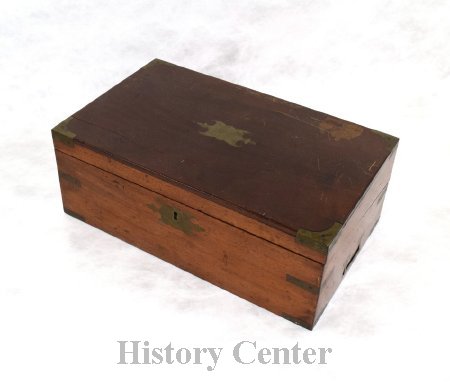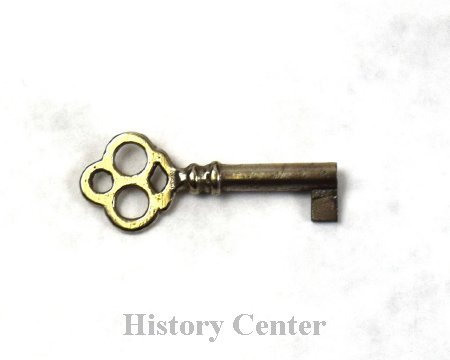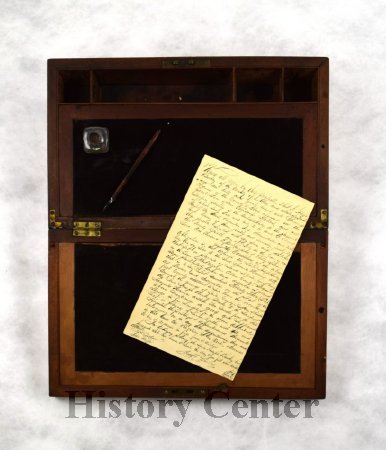Date:
c. 1840s-1850s
Title:
Samuel Hanna Writing Desk
Description:
Surveyor of the Summit City: Samuel Hanna (1797-1866)
Samuel Hanna bridged the gap in Fort Wayne's history between frontier settlement and young city. Hanna moved to Fort Wayne in 1819 to trade with the Miami. Realizing the temporary nature of the Indian trade, Hanna began more long-term investments that helped promote both the region and his own economic interests such as land speculation, milling, the Wabash and Erie Canal, banking and railroads.
When Allen County was established in 1824, Hanna was appointed the first postmaster and elected associate judge of the Circuit Court. Through the efforts of Hanna and the investment by the Fort Wayne Branch of the State Bank of Indiana, funds were raised for the planking of the 50-mile long Lima Road connecting Fort Wayne to LaGrange County. The newly planked Lima Road, though an improvement on earlier roads, proved to be too costly to maintain. Soon Hanna became engaged in canal development. When Hanna's team fell ill and deserted him while surveying land around Fort Wayne, Hanna and David Burr took on the task to complete the work. He was appointed to the state's canal commission, which oversaw the Lake Erie extension to the Ohio River. This would become North America's longest canal.
Hanna laid out his first addition to Fort Wayne in 1837, known as Hanna's Addition located on the near east side of town, giving the city a portion of land to use as a public market. Barr Street Market, the oldest public space in Fort Wayne, is still in use today and sits adjacent to the History Center. When westward railroad expansion threatened to bypass Fort Wayne, Hanna used his influence in the state legislature to insure new railroads in northern Indiana were centered in Allen County. In 1852 Samuel Hanna donated five acres of land near the proposed route of the Pittsburgh, Fort Wayne and Chicago Railroad to be used for repair and construction shops.
Hanna's business interests and involvement in developing regional infrastructure required a lot of travel. The portable desk was a convenient appliance for a man on the road, providing storage space for pens, pencils, ink, wafers and papers, and a felt surface for writing letters and documents.
Samuel Hanna bridged the gap in Fort Wayne's history between frontier settlement and young city. Hanna moved to Fort Wayne in 1819 to trade with the Miami. Realizing the temporary nature of the Indian trade, Hanna began more long-term investments that helped promote both the region and his own economic interests such as land speculation, milling, the Wabash and Erie Canal, banking and railroads.
When Allen County was established in 1824, Hanna was appointed the first postmaster and elected associate judge of the Circuit Court. Through the efforts of Hanna and the investment by the Fort Wayne Branch of the State Bank of Indiana, funds were raised for the planking of the 50-mile long Lima Road connecting Fort Wayne to LaGrange County. The newly planked Lima Road, though an improvement on earlier roads, proved to be too costly to maintain. Soon Hanna became engaged in canal development. When Hanna's team fell ill and deserted him while surveying land around Fort Wayne, Hanna and David Burr took on the task to complete the work. He was appointed to the state's canal commission, which oversaw the Lake Erie extension to the Ohio River. This would become North America's longest canal.
Hanna laid out his first addition to Fort Wayne in 1837, known as Hanna's Addition located on the near east side of town, giving the city a portion of land to use as a public market. Barr Street Market, the oldest public space in Fort Wayne, is still in use today and sits adjacent to the History Center. When westward railroad expansion threatened to bypass Fort Wayne, Hanna used his influence in the state legislature to insure new railroads in northern Indiana were centered in Allen County. In 1852 Samuel Hanna donated five acres of land near the proposed route of the Pittsburgh, Fort Wayne and Chicago Railroad to be used for repair and construction shops.
Hanna's business interests and involvement in developing regional infrastructure required a lot of travel. The portable desk was a convenient appliance for a man on the road, providing storage space for pens, pencils, ink, wafers and papers, and a felt surface for writing letters and documents.







